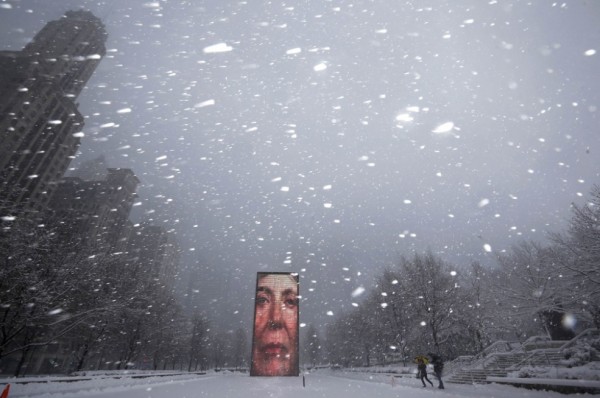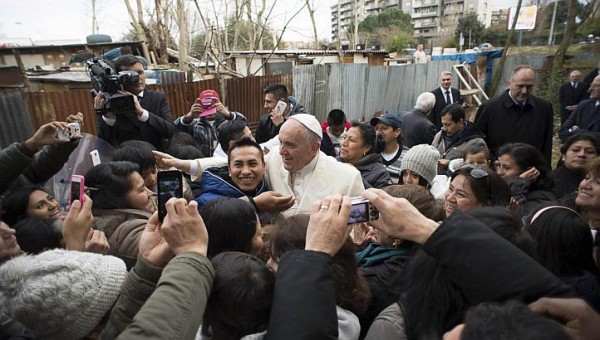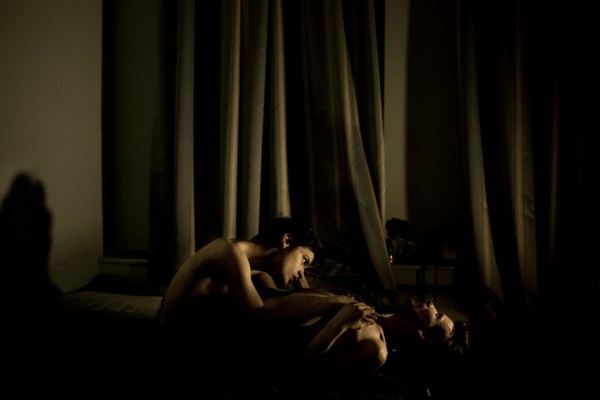Perhaps Our Images Provide Opportunities to Turn Terror Into Something Else
Terrifying, isn’t it? A disembodied head, as if from some hideous experiment or alien communication: gargantuan, strange, yet familiar enough to be uncanny, both human and nonhuman. Seemingly imprisoned in a mechanical frame, and yet haughty, as if in a position of command and sure to judge harshly. The central monument in a civic plaza, yet looking more like an idol demanding sacrifice, the image radiates a dark vibe across the urban space. Looming buildings, ice-shrouded railings, bare trees, wind-driven snow, empty spaces, and stragglers in the storm–all these signs of winter’s desolation seem warm and reassuring by comparison with the aggressive presence of that digital face.
I had been trolling through the online slide shows: pictures of the day, pictures of the week, editor’s choice, carnival, fashion week, you name it. Many were images with little news value, images obviously selected for their storefront appeal: human interest, eye candy, call it what you will. Amidst these litanies of the same, images every one, there was nothing that stopped me to take a second look, nothing that pushed me to the edge of my comfort zone, nothing the created anything like an encounter with the medium itself. (You can say I’ve seen too much of this stuff, and you’d be right, but it also was a slow day at the slide shows, which much of the time are archives of remarkable photojournalism.) And then I saw the image that is the equivalent of a terrorist attack on public spectatorship.
For the record, you are looking at the Crown Fountain video sculpture in Chicago’s Millennium Park. The artwork is one of two that bookend a wading pool, with the faces changing every half minute or so. In the summer, the plaza is thronged with kids and sightseers, and you see the faces of happy strangers everywhere–including on the large video screens. Even then, however, the sculpture is not simply a precipitant for civic amusement, for it still doubles as a work of art: always a bit uncanny, always a copy of someone and no one and everyone, always a familiar yet anonymous face that is expressive but following some impersonal logic of mechanical display.
By catching that face amidst the winter storm, the photographer was able to pull out this second sense of the artwork. By doing it with a photograph, he made the artwork doubly reflexive: the disembodied face is now saying something about photography. Or “saying” might not be the right verb. It is showing us one thing, the image as image, to evoke another: the terror of the image. As W.J.T. Mitchell has noted, every theory of imagery is likely to have a fear of imagery lurking within (What Do Pictures Want?, page 342), and the same is true of all of us with our more intuitive relationship to the image world. Human beings, no matter how modern, project animate powers into images, and fear is an unavoidable consequence. Indeed, a statement of Mitchell’s can double as a description of the photograph above: “Pictures are things that have been marked with all the stigmata of personhood and animation: they exhibit both physical and virtual bodies; the speak to us, sometimes literally, sometimes figuratively; or they look back at us silently across a “gulf unbridged by language’” (page 30, quoting John Berger).
And so the idolatrous face stares at us across a gulf unbridged by language. The result is a form of terror: the deep anxiety that lies within our relationship to our media technologies and images of every kind, the fear that we may be duplicated or displaced, and that we already have been so, already become images to each other and even to ourselves, strangers in a strange land.
But fear not. You can’t see it easily in this photograph, but the challenge is there. The face you see, even in the mirror, is the face of the other; to see the other, you have to see a face. Here I am channeling (very roughly) Emmanuel Levinas, and especially as articulated by Judith Butler in Precarious Life (pp. 131 ff.): to see the face of the other, wherever one might find it, is to enter into the extreme vulnerability of human life, the precariousness of living with one another. It is the beginning of an ethical relationship, and the essential condition for peace.
If Butler and Levinas were wrong, it would not be troubling to see that a face is an image. The image seems inhuman, because a face is the face of humanity. The image above presses the point, as it seems that that image wants to kill you. (What do images want? Your head.) And no doubt there are things to fear: objectification, mechanization, and other elements of human viciousness and modern society are very real dangers, always. (Setting them in a place known as Millennium Park is hardly reassuring: welcome to the new millennium, slave.) But let me suggest that the idol in the park doesn’t want a sacrifice. So what might the sculpture, and the photograph, really want?
Perhaps they want what every image might want: to be seen for what it is, a face. Perhaps our images provide opportunities to turn terror into something else, something better suited to living with others. If we could go to school there, perhaps we wouldn’t have to go to war later. After all, what is terror but a fear of our other self.
-Robert Hariman
(cross-posted from No Caption Needed)
Photograph by Jim Young/Reuters. Recommended reading, though having no responsibility for any errors of my own in this post: Hagi Kenaan, The Ethics of Visuality: Levinas and the Contemporary Gaze.



Reactions
Comments Powered by Disqus